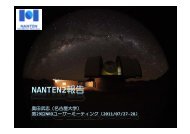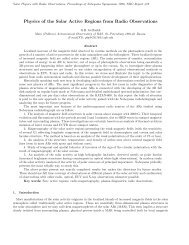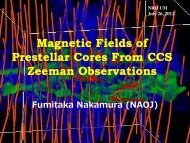Millimeter Interferometer Observations of Flares - Nobeyama Solar ...
Millimeter Interferometer Observations of Flares - Nobeyama Solar ...
Millimeter Interferometer Observations of Flares - Nobeyama Solar ...
You also want an ePaper? Increase the reach of your titles
YUMPU automatically turns print PDFs into web optimized ePapers that Google loves.
<strong>Solar</strong> Physics with Radio <strong>Observations</strong>, Proceedings <strong>of</strong> <strong>Nobeyama</strong> Symposium 1998, NRO Report 479<br />
<strong>Millimeter</strong> <strong>Interferometer</strong> <strong>Observations</strong> <strong>of</strong> <strong>Flares</strong><br />
Stephen M. White<br />
Astronomy Department, University <strong>of</strong> Maryland, College Park, MD 20742, U.S.A.<br />
E-mail: white@astro.umd.edu<br />
Abstract<br />
This paper addresses the current state <strong>of</strong> millimeter interferometry <strong>of</strong> solar flares and the issues which<br />
can be addressed by such observations. <strong>Millimeter</strong> interferometers such as BIMA detect gyrosynchrotron<br />
emission from MeV–energy electrons in the impulsive phase <strong>of</strong> solar flares as well as from hot dense plasma<br />
in the thermal decay phase. BIMA now consists <strong>of</strong> 10 antennas and is capable <strong>of</strong> snapshot imaging <strong>of</strong> solar<br />
flares with excellent spatial resolution and dynamic range <strong>of</strong> up to 100. The properties <strong>of</strong> MeV–energy<br />
electrons deduced from such observations vary widely: in some flares they are present for a much shorter<br />
time than the lower–energy hard–X–ray producing electrons, while in other flares they are present longer.<br />
Examples <strong>of</strong> both circumstances are given. It is widely observed that the energy distribution determined<br />
from the optically–thin radio spectrum is inconsistent with that determined from hard X–ray data: generally<br />
this is interpreted to mean that the electron energy distribution is flatter at higher energies, but even this<br />
interpretation can run into difficulties. This discrepancy between radio and hard X–ray spectral indices<br />
may be revealing something fundamental about electron acceleration in solar flares.<br />
Key words: Sun: flares — Sun: radio radiation — Instrumentation: interferometers<br />
1. Introduction<br />
The general properties <strong>of</strong> millimeter emission from solar flares are now well–established: it is produced both in the<br />
impulsive phase and in the gradual decay phase <strong>of</strong> flares. The importance <strong>of</strong> millimeter–wavelength observations in<br />
the impulsive phase is that they are only sensitive to the most energetic electrons acccelerated by solar flares, and<br />
not the electrons in the energy range below 500 keV which can dominate microwave emission. This fact results from<br />
the combination <strong>of</strong> the characteristics <strong>of</strong> the mechanism which produces the impulsive radio emission from solar<br />
flares (gyroresonance emission, i.e., radiation due to the acceleration <strong>of</strong> electrons spiraling in a magnetic field), and<br />
the range <strong>of</strong> magnetic field strengths typical <strong>of</strong> the corona. Gyroresonance emission takes place at harmonics <strong>of</strong> the<br />
local gyr<strong>of</strong>requency, broadened by thermal motion. Typical coronal gyr<strong>of</strong>requencies have an upper limit <strong>of</strong> order<br />
5 GHz, so that any gyroemission at our observing frequency (∼ 90 GHz, wavelength 3.5 mm) must be produced<br />
at gyroharmonics <strong>of</strong> at least 20, and usually higher. However, nonrelativistic electrons have effectively no opacity<br />
at such high harmonics: we know from the theory <strong>of</strong> gyroemission (i.e., synchrotron theory, in the high harmonic<br />
limit) that the typical harmonic radiated by a particle with energy γmc 2 is γ 3 . Thus emission at harmonics higher<br />
than 20 requires electrons with γ at least <strong>of</strong> order 3. Quantitative calculations verify the conclusion that only MeV–<br />
energy electrons can produce significant gyrosynchrotron emission at 3 mm wavelength (White & Kundu 1992).<br />
These electrons radiate so strongly that they make millimeter observations a much more sensitive diagnostic <strong>of</strong> MeV<br />
electrons than are γ–ray observations: we have demonstrated that even in small flares (down to C1GOES s<strong>of</strong>t X–ray<br />
class) the impulsive–phase emission is readily detected, and thus MeV electrons can be studied (Kundu et al. 1990;<br />
White et al. 1992; Lim et al. 1992; Kundu et al. 1994).<br />
The principal scientific issue addressed by millimeter observations <strong>of</strong> flares is the acceleration <strong>of</strong> electrons to high<br />
energies in solar flares. It is well established that in the impulsive phase <strong>of</strong> solar flares, energy is converted from a form<br />
stored as magnetic field energy into particle kinetic energy. One aspect <strong>of</strong> this conversion is the production <strong>of</strong> the<br />
20–200 keV electrons which produce the bulk <strong>of</strong> the observed hard X-rays, and GRO’s detectors are sensitive enough<br />
to see hard X-rays in this energy range from virtually all flares. There is evidence from hard X–ray observations<br />
that typical flare energy spectra show a “break downwards” in this energy range, with the spectrum becoming<br />
steeper at high energies. On the other hand, observations <strong>of</strong> the radio spectrum out to millimeter wavelengths<br />
suggest the opposite result: namely, that there is a flattening <strong>of</strong> the electron energy spectrum at high energies (∼ 1<br />
MeV), required to explain the relatively large millimeter fluxes detected in observations with millimeter–wavelength
224 S. M. White<br />
arcsec<br />
arcsec<br />
30<br />
20<br />
10<br />
0<br />
-10<br />
-20<br />
-30<br />
30<br />
20<br />
10<br />
0<br />
-10<br />
-20<br />
16:54 UT 16:56 UT<br />
16:59 UT<br />
17:02 UT<br />
Beam<br />
-30<br />
-30 -20 -10 0 10 20 -30 -20 -10 0 10 20 30<br />
arcsec<br />
arcsec<br />
GOES-predicted radio flux (sfu)<br />
3<br />
2<br />
1<br />
0<br />
GOES data: 96 July 11<br />
16:50 17:00 17:10 17:20<br />
UT 96 July 11<br />
Fig. 1.. BIMA observation (using 9 antennas) <strong>of</strong> a gradual flare on 1996 July 11. The images at left show the evolution <strong>of</strong> the radio<br />
source with time. The beam size is 7 ′′ × 6 ′′ (shown in the bottomleft panel). The source is well resolved at this resolution. The<br />
panel on the right compares the behaviour <strong>of</strong> the radio flux at 86 GHz expected to be emitted from the s<strong>of</strong>t–X–ray–emitting plasma<br />
detected by the GOES satellites (solid line) with the (scaled) CLEANed fluxes obtained fromthe images. This event is consistent<br />
with being a purely thermal event, with no nonthermal emission. The dynamic range <strong>of</strong> the 17:02 UT image is <strong>of</strong> order 100 (after<br />
self–calibration). Contours are plotted at multiples 3, 4, 6, 8, 12, 16, 24, 32, 48, 64, 80, and 96 <strong>of</strong> 2.5 Jy (negative contours are<br />
dashed).<br />
telescopes. Occasionally such flattening is also seen in the hard X–ray spectra <strong>of</strong> very large flares (e.g., Dennis 1988,<br />
Trottet 1998). The combination <strong>of</strong> these two results suggests that there are several distinct electron populations<br />
produced in flares: the 20–200 keV population, which receives the bulk <strong>of</strong> the energy converted to electron kinetic<br />
energy; and a hard component which typically has a flatter spectrum.<br />
We discuss these issues in the remainder <strong>of</strong> this paper with the aid <strong>of</strong> two examples. The next section, however,<br />
presents an example <strong>of</strong> the sort <strong>of</strong> flare data which can be acquired with BIMA, presently consisting <strong>of</strong> 10 antennas.<br />
2. Current Capabilities <strong>of</strong> <strong>Millimeter</strong> Interferometry<br />
Most millimeter interferometer observations <strong>of</strong> flares have been carried out with the Berkeley–Illinois–Maryland<br />
Array (BIMA) in northern California. This array has been evolving over the years (it is funded by the NSF and<br />
the university partners for primarily galactic and extragalactic studies, with a significant solar component), from a<br />
3–element array during the first solar observations (Kundu et al. 1990) to a 6–element array which was used for<br />
the first true high–spatial–resolution interferometer images <strong>of</strong> a flare (Silva et al. 1996; Silva et al. 1997) and more<br />
recently a 9–element array and now a 10–element array. The significance <strong>of</strong> the number <strong>of</strong> antennas in the array is<br />
the improvement in the instantaneous spatial coverage <strong>of</strong> the telescope: the number <strong>of</strong> baselines, each corresponding<br />
to a different spatial scale on the sky, increases as the square <strong>of</strong> the number <strong>of</strong> antennas, so we are able to map much<br />
more complicated structures when we have more antennas.<br />
Figure 1demonstrates this for an event observed with 9 antennas in 1996. This particular event showed no<br />
evidence for non–thermal emission: as the right panel <strong>of</strong> Figure 1shows, the behaviour <strong>of</strong> the radio flux observed by<br />
BIMA matches the expected thermal emission from the s<strong>of</strong>t–X–ray–emitting plasma very well during the rise <strong>of</strong> the<br />
X–rays. It does not match as well during the decay, but that is to be expected if the source size expands so that it<br />
is larger than the largest spatial scale which the interferometer can measure. Note that the flux scales do not match
<strong>Millimeter</strong> <strong>Interferometer</strong> <strong>Observations</strong> <strong>of</strong> <strong>Flares</strong> 225<br />
Counts/sec<br />
Counts/sec<br />
Flux (sfu)<br />
3•10 4<br />
2•10 4<br />
1•10 4<br />
0<br />
800<br />
600<br />
400<br />
200<br />
0<br />
150<br />
Flux (sfu)<br />
100<br />
50<br />
0<br />
6<br />
4<br />
2<br />
0<br />
1991 Jun 13<br />
25 - 50 keV HXR<br />
.1 - .3 MeV HXR<br />
8.8 GHz (RSTN)<br />
86 GHz (BIMA)<br />
18:00 18:01 18:02 18:03<br />
Time (UT)<br />
Fig. 2.. The time pr<strong>of</strong>ile <strong>of</strong> a flare observed on 1991 June 13 in two hard X–ray energy ranges <strong>of</strong> the BATSE large-area detector (as<br />
labeled), at 8.8 GHz (RSTN data) and at 86 GHz (BIMA data). Note that the 25 – 50 keV emission continues much longer than do<br />
the higher-energy X-rays: the latter are confined to a hard spike at the onset <strong>of</strong> the flare. The time resolution <strong>of</strong> the BATSE data is<br />
1.024 s.<br />
exactly as shown: the BIMA amplitudes have been scaled by a factor <strong>of</strong> order 2 for presentation. Possible causes for<br />
this discrepancy are that the fit to the GOES data does not represent all the material present, the assumed [Fe/H]<br />
abundance may be wrong or BIMA’s calibration may be wrong. The gap in the BIMA fluxes from 17:03 – 17:09<br />
resulted from a calibrator observation.<br />
The images in Figure 1were made by first carrying out a preflare subtraction <strong>of</strong> the visibilities and then mapping<br />
and self-calibrating the resulting data set (the shortest baseline was omitted from the data because the preflare flux<br />
was very large and preflare subtraction did not work very well on this baseline). At the peak <strong>of</strong> the flare the source<br />
is quite large and well–resolved by the 7 ′′ × 6 ′′ beam. The nominal signal–to–noise achieved was <strong>of</strong> order 100, which<br />
roughly matches that achieved during VLA microwave snapshot imaging <strong>of</strong> flares.<br />
These images demonstrate the potential <strong>of</strong> millimeter interferometry for solar flare work. Presently BIMA has<br />
10 antennas but with new receivers which require a special solar calibration scheme presently being developed. We<br />
expect that it will provide some excellent data during the coming solar maximum.<br />
3. Event <strong>of</strong> 1991 June 13: Hard–S<strong>of</strong>t Evolution<br />
In this section we present an event which demonstrates the general result that the MeV–energy electrons seem<br />
to be a population quite different from the accelerated electrons which produce hard X–rays (White et al. 1998).<br />
Figure 2 presents light curves in two hard X–ray energy ranges, one microwave frequency on the optically–thick side<br />
<strong>of</strong> the radio spectrum, and millimeter data on the optically–thin side <strong>of</strong> the radio spectrum. This particular event<br />
has several interesting features: X–rays are only detected in the harder channel during a spike in the impulsive rise
226 S. M. White<br />
phase <strong>of</strong> the event. Thereafter the hard X–ray flux in the lower energy range remains at the same level for almost 2<br />
minutes, while the high–energy photons vanish after about 15 seconds. Spectral analysis <strong>of</strong> the X–ray data shows a<br />
sharp s<strong>of</strong>tening <strong>of</strong> the spectrum in accord with the light curves. The photon spectral index is about 4.5 during the<br />
initial hard spike but drops to about 6 later in the event.<br />
The 8.8 GHz microwave data show a pr<strong>of</strong>ile which is quite similar to the lower-energy hard X–rays, albeit with a<br />
slightly more pronounced spike at onset. The 86 GHz time pr<strong>of</strong>ile, on the other hand, is clearly more similar to the<br />
100 – 300 keV hard X–ray pr<strong>of</strong>ile, with emission only during a brief spike at onset (emission consistent with thermal<br />
bremsstrahlung from the s<strong>of</strong>t–X–ray–emitting plasma is also seen later in the event). This event thus suggests that<br />
MeV–energy electrons are only present during the onset <strong>of</strong> the event, whereas lower-energy 25 keV–X–ray–emitting<br />
electrons are present for a much longer time. Such behaviour is not consistent with, for example, the collisional<br />
evolution <strong>of</strong> a single population <strong>of</strong> electrons injected at flare onset: collisional evolution removes the lower–energy<br />
electrons first, since they have higher collision rates. Thus the character <strong>of</strong> electron acceleration apparently changed<br />
during the course <strong>of</strong> the event.<br />
In this event, we do not have the data to determine whether the millimeter data are consistent with the hard X–ray<br />
spectrum during the hard spike at the onset <strong>of</strong> the flare: the radio spectrum had a very high turnover frequency<br />
and we do not have any other frequency clearly known to be above the spectral peak apart from the millimeter<br />
data. Taking the BIMA flux, extrapolating it lower in frequency according to the energy distribution <strong>of</strong> the hard<br />
X–ray–emitting electrons and comparing the result with the measured 15 GHz flux, we can say that the turnover<br />
frequency had to be well over 20 GHz, which is unusual.<br />
The next event is one in which the addition <strong>of</strong> imaging data at millimeter wavelengths allows much tighter<br />
constraints to be placed on the electron populations present.<br />
4. Event <strong>of</strong> 1994 August 16: S<strong>of</strong>t–Hard Evolution<br />
This event occurred in AR 7765 on August 16, 1994, at 23 UT and was classified as a GOES B5.6 X-ray flare<br />
with peak emission at 23:12 UT. We have NRH, BIMA and OVRO radio data and CGRO/BATSE hard X–ray data<br />
for this event, and Yohkoh/SXT s<strong>of</strong>t X–ray images during the decay phase but not the impulsive phase (Raulin<br />
et al. 1998). The remarkable aspect <strong>of</strong> this flare is evidence for the presence <strong>of</strong> MeV–energy electrons, which are<br />
responsible for the nonthermal millimeter emission, at a time when no hard X–rays from lower–energy electrons are<br />
detected. Figure 3 presents light curves in hard X–rays and at several radio frequencies from 3 to 86 GHz. The<br />
puzzling period <strong>of</strong> nonthermal millimeter emission in the absence <strong>of</strong> detectable hard X–ray emission occurs during<br />
a smoothly varying phase (23:04:20 – 23:07:00) which is seen at radio wavelengths to last several minutes and is the<br />
brightest phase at millimeter wavelengths, but is undetected in hard X–rays: it follows a brief spike <strong>of</strong> emission at<br />
flare onset which has the more usual properties <strong>of</strong> impulsive events and features nonthermal microwave, millimeter<br />
and hard X–ray emission.<br />
We interpret the phase which is brightest at millimeter wavelengths as due to efficient trapping <strong>of</strong> a relatively<br />
small number <strong>of</strong> nonthermal electrons, whereas during the hard X–ray emission trapping is much less efficient and<br />
the decay time is much shorter at all energies, leading to a larger ratio <strong>of</strong> hard X–ray flux to radio flux. There<br />
does need to be a separate injection <strong>of</strong> electrons to explain the millimeter phase, since the number <strong>of</strong> MeV–energy<br />
electrons present in the corona clearly must be increasing from 23:04 to 23:05 UT in order for the optically–thin<br />
radio flux at 17 and 86 GHz to be increasing during this time, and this increase cannot be achieved simply by<br />
a change in the energy distribution such as removing the low–energy electrons. “Second–step” acceleration, as is<br />
invoked by Frost & Dennis (1971) for a similar–looking event in hard X–rays, is a possible explanation but requires<br />
that the seed electrons accelerated in the impulsive phase be trapped somewhere in the corona from where they<br />
cannot escape (since the HXR bremsstrahlung ceases at 23:04 UT) until the second acceleration mechanism kicks in<br />
and accelerates them subsequently when the millimeter emission is observed. Further, since the millimeter emission<br />
during the hard X–ray phase decays as rapidly as the hard X–rays and microwaves, the trapping time in the hard<br />
X–ray phase <strong>of</strong> the event must be short for all energies. This again is not consistent with collisional scattering, which<br />
causes lower–energy electrons to have much shorter trapping times than MeV–energy electrons.<br />
As in many previous events studied at millimeter wavelengths, there is a discrepancy between the electron energy<br />
spectral indices inferred from the millimeter and hard X–ray data during the impulsive phase when both are detected:<br />
again it appears that the energy spectrum at 1MeV must be significantly flatter than at several hundred keV and<br />
below. Based on the thick–target assumption for the hard X–rays, the electrons emitting the hard X–rays have<br />
an E −4.9 energy distribution, while the radio–emitting electrons have an E −3.6 distribution. As has been usual in<br />
the past, we could simply assume that the radio–emitting electrons are a higher–energy component with a flatter
<strong>Millimeter</strong> <strong>Interferometer</strong> <strong>Observations</strong> <strong>of</strong> <strong>Flares</strong> 227<br />
Photons s -1 cm -2<br />
sfu<br />
0.030<br />
0.020<br />
0.010<br />
0.000<br />
sfu<br />
sfu<br />
sfu<br />
1.5<br />
1.0<br />
0.5<br />
0.0<br />
25<br />
20<br />
15<br />
10<br />
5<br />
0<br />
30<br />
20<br />
10<br />
BATSE hard X-rays<br />
BIMA 86 GHz<br />
NRH 17 GHz<br />
OVRO 9.0 GHz<br />
0<br />
20<br />
OVRO 3.4 GHz<br />
15<br />
10<br />
5<br />
0<br />
23:01 23:04 23:07 23:10<br />
Time (UT)<br />
Fig. 3.. Comparison <strong>of</strong> time pr<strong>of</strong>iles observed by BATSE, OVRO, BIMA and NRH during the impulsive phase and initial part <strong>of</strong> the<br />
gradual phase <strong>of</strong> the flare on 1994 August 16. The top panel shows the BATSE hard X–ray light curve. The second panel shows the<br />
BIMA 86 GHz flux measured on the longest baseline, in order to highlight the brief impulsive spike at 23:04 UT; note that the peak<br />
flux on shorter baselines is larger than shown here. The third panel shows 17 GHz data fromNRH. These data are the “correlation<br />
coefficient” data which measure the flux in compact sources, scaled to match the flux in maps made at discrete times during the event<br />
fromwhich the absolute flux can be determined. The three lower panels show the correlated flux between the two 27 mantennas at<br />
OVRO at 9.0 (3rd panel), 7.0 (4th panel) and 3.4 GHz (bottompanel), at 12 second time resolution.
228 S. M. White<br />
spectrum than the hard X–ray emitting electrons. However, the fact that we can image the millimeter source in<br />
this case imposes constraints on the parameters <strong>of</strong> the radiating electrons. During the hard X–ray emission, BIMA<br />
measures an 86 GHz source size <strong>of</strong> order 13 ′′ × 7 ′′ . For a magnetic field <strong>of</strong> 300 G in the radio source, which is<br />
consistent both with a photospheric magnetogram and with the location <strong>of</strong> the radio spectral peak, the number <strong>of</strong><br />
electrons required to explain the observed radio fluxes exceeds at 50 keV the number <strong>of</strong> electrons required to explain<br />
the hard X–ray flux from a loop <strong>of</strong> the observed dimension. In other words, hard X–rays from the radio–emitting<br />
electrons should dominate the hard X–ray spectrum, and should produce a photon spectral index consistent with<br />
the radio spectrum. If the parameters <strong>of</strong> the source were not known, we could not constrain the electron numbers<br />
in this fashion, demonstrating the power <strong>of</strong> the imaging data. The discrepancy between the two populations can be<br />
ameliorated by assuming a much larger magnetic field than is plausible based on the photospheric fields, but it does<br />
not vanish (Raulin et al. 1998).<br />
5. Discussion<br />
This paper has emphasized the ways in which millimeter observations <strong>of</strong> flares can be used in conjunction with<br />
microwave and hard X–ray data to examine the different electron populations accelerated in solar flares. The<br />
millimeter data clearly imply that the higher–energy electrons which radiate at millimeter wavelengths belong to a<br />
population different from the nonthermal electrons which radiate at hard X–ray energies.<br />
In particular, radio data almost always imply a harder energy spectrum than do hard X–ray data (e.g., Alissandrakis<br />
1986; Staehli, Gary & Hurford 1989; Nitta et al. 1991; Lim et al. 1992; Kundu et al. 1994; Silva et al. 1996;<br />
Silva et al. 1997). Usually we dismiss this as due to a break upwards in the energy distribution at some point,<br />
although most X–ray astronomers assume a break down at around 100 keV (Lin & Schwartz 1987; Dulk, Kiplinger<br />
& Winglee 1992). However, such a broken–up spectrum may not always be truly quantitatively consistent with<br />
the data, as in the 1994 August 16 event, and it is possible that such an interpretation is overlooking something<br />
important about the emission <strong>of</strong> solar flares. High–quality multi–wavelength (hard X–ray, s<strong>of</strong>t X–ray, microwave<br />
and millimeter) spatially–resolved observations are required to address this issue.<br />
This work has been supported by NSF grant ATM-96-12738 and NASA grant NAG-W-1541. This research has<br />
made use <strong>of</strong> data obtained through the CGRO BATSE <strong>Solar</strong> Flare Data Archive maintained by the <strong>Solar</strong> Data<br />
Analysis Center at NASA-Goddard Space Flight Center and provided by the BATSE team headed by Dr. Gerald<br />
Fishman. The s<strong>of</strong>t x-ray images are from the Yohkoh mission <strong>of</strong> ISAS, Japan. The s<strong>of</strong>t x-ray telescope was prepared<br />
by the Lockheed Palo Alto Research Laboratory, the National Astronomical Observatory <strong>of</strong> Japan, and the University<br />
<strong>of</strong> Tokyo with the support <strong>of</strong> NASA and ISAS. I thank the referee for comments which improved the paper.<br />
References<br />
Alissandrakis, C. E. 1986, <strong>Solar</strong> Phys., 104, 207.<br />
Dennis, B. R. 1988, <strong>Solar</strong> Phys., 118, 49.<br />
Dulk, G. A., Kiplinger, A. L., & Winglee, R. M. 1992, ApJ, 389, 756.<br />
Frost, K. J., & Dennis, B. R. 1971, ApJ, 165, 655.<br />
Kundu, M. R., White, S. M., Gopalswamy, N., Bieging, J. H., & Hurford, G. J. 1990, ApJL, 358, L69.<br />
Kundu, M. R., White, S. M., Gopalswamy, N., & Lim, J. 1994, ApJS, 90, 599.<br />
Lim, J., White, S. M., Kundu, M. R., & Gary, D. E. 1992, <strong>Solar</strong> Phys., 140, 343.<br />
Lin, R. P., & Schwartz, R. A. 1987, ApJ, 312, 462.<br />
Nitta, N., White, S. M., Schmahl, E. J., & Kundu, M. R. 1991, <strong>Solar</strong> Phys., 132, 125.<br />
Raulin, J., White, S. M., Kundu, M. R., Silva, A. R., & Shibasaki, K. 1998, ApJ, submitted.<br />
Silva, A. V. L., Gary, D. E., White, S. M., Lin, R. P., & de Pater, I. 1997, <strong>Solar</strong> Phys., 175, 157.<br />
Silva, A. V. L., White, S. M., Lin, R. P., de Pater, I., Shibasaki, K., Hudson, H. S., & Kundu, M. R. 1996, ApJL, 458, L49.<br />
Staehli, M., Gary, D. E., & Hurford, G. J. 1989, <strong>Solar</strong> Phys., 120, 351.<br />
Trottet, G., Vilmer, N., Barat, C., Benz, A., Magun, A., Kuznetsov, A., Sunyaev, R., & Terekhov, O. 1998 , A&A, 334, 1099.<br />
White, S. M., & Kundu, M. R. 1992, <strong>Solar</strong> Phys., 141, 347.<br />
White, S. M., Kundu, M. R., Bastian, T. S., Gary, D. E., Hurford, G. J., Kucera, T., & Bieging, J. H. 1992, ApJ, 384, 656.<br />
White, S. M., Schwartz, R. A., Murphy, R., Kundu, M. R., & Gopalswamy, N. 1998, ApJ, in preparation.














